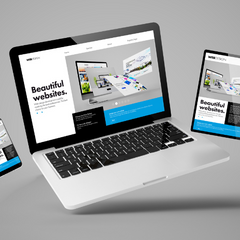
Ready to dive into website copywriting but not sure where to begin?
Wondering how much you should charge for your services?
Curious about the essential sections of a website you'll be writing copy for?
Look no further.
This ultimate guide was made for YOU.
I’ll answer all your burning questions about website copywriting.
In just a few minutes, you’ll learn everything you need to know to kickstart your journey as a successful website copywriter.
From understanding the basics of website copywriting to mastering advanced techniques, I’ve got you covered, amigo.
What is Website Copywriting?

Website copywriting is all about using words to grab attention, engage visitors, and compel them to take action on a website.
It's the skill of crafting persuasive content that not only informs but also persuades readers to do something.
Make a purchase…
Sign up for a newsletter…
Contact a business…
As a web copywriter, you're the voice of the brand online.
Your words have the power to shape perceptions, build trust, and drive conversions.
Every headline, paragraph, and call-to-action you write plays a crucial role in guiding visitors through the website and ultimately towards the desired goal.
How Much Should You Charge for Website Copywriting?

Wondering how to put a price tag on your website copywriting services?
It's a common question for many aspiring copywriters.
Determining your rates can feel like navigating uncharted waters.
As a web copywriter, your rates should reflect not only your skill level and experience but also the value you bring to your clients.
Consider factors such as the complexity of the project, the time and effort required, and the results you aim to deliver.
Remember, you're not just selling words – you're selling solutions that can help businesses solve their achy problems and achieve their lofty goals.
Here are the most common pricing structures to offer:
Hourly Rate
Charging by the hour is a straightforward way to bill for your time.
Your hourly rate should account for your expertise, overhead costs, and the market rate for copywriting services in your area.
Hourly rates can range anywhere from $50 to $200 or more, depending on your experience level and the complexity of the project.
Per Project
Many copywriters prefer to quote a flat fee for each project based on its scope and requirements.
This approach allows for greater flexibility and transparency, as clients know exactly what to expect in terms of cost.
Project-based pricing can vary widely depending on factors such as the number of pages, the level of research involved, and the desired outcomes.
A simple landing page might cost anywhere from $300 to $1000, while a comprehensive website overhaul could command several thousand dollars.
Retainer
Some copywriters work on a retainer basis, where clients pay a monthly fee for a set number of hours or projects.
Retainer agreements provide stability and ongoing income for you while ensuring that the client has access to their services whenever needed.
Retainer fees typically range from a few hundred to a few thousand dollars per month, depending on the scope of work and the level of commitment required.
Ultimately, the key to setting your rates is to know your worth, understand the value you bring to your clients, and communicate that value effectively.
Don't be afraid to negotiate or adjust your rates as needed to ensure a fair and mutually beneficial arrangement for both parties.
To learn more about how to price your copywriting services, see this ultimate guide.
What Are the Most Popular Website Copywriting Services to Offer Clients?

Curious about the types of services you can offer as a web copywriter? Let's explore some of the most popular options that clients often seek when looking to enhance their online presence.
Website Content Creation
This includes writing compelling copy for all pages of a website, such as the homepage, about page, services or product pages, and contact page. Each page serves a unique purpose in guiding visitors through the site and encouraging them to take action, whether it's making a purchase or getting in touch with a business.
SEO Copywriting
Search engine optimization (SEO) is essential for improving a website's visibility in search engine results pages. SEO copywriting involves incorporating relevant keywords and phrases into your website copy to help it rank higher in search engine rankings. By optimizing your content for search engines, you can attract more organic traffic to your client's website and increase their online visibility.
Blog Writing
Many businesses maintain a blog as part of their content marketing strategy to engage their audience and establish themselves as industry experts. As a website copywriter, you can offer blog writing services to help clients consistently publish high-quality, informative content that resonates with their target audience and drives traffic to their website.
Email Marketing Campaigns
Email marketing remains one of the most effective ways to nurture leads and convert prospects into customers. Offer clients email copywriting services to create engaging, persuasive email campaigns that promote their products or services, drive conversions, and build customer loyalty.
Content Strategy Development
Beyond writing copy, you can also offer strategic guidance to clients on developing a comprehensive content strategy for their website.
This might include conducting audience research, identifying content gaps, and creating a content calendar to ensure a steady stream of fresh, relevant content that aligns with their business objectives.
By diversifying your service offerings and catering to the unique needs of your clients, you can position yourself as a valuable partner in helping them achieve their online marketing goals.
The Main Sections of a Website You’ll Write Copy For

Now that we've covered some popular services you can offer as a website copywriter, let's dive into the main sections of a website where your copywriting skills will shine.
Understanding the purpose and key elements of each section will help you write engaging and persuasive copy that resonates with your client's target audience.
Homepage
The homepage is often the first impression visitors have of a website. It should grab their attention, clearly communicate what the business offers, and guide them deeper into the site. Your homepage copy should be concise, engaging, and persuasive, highlighting the unique value proposition of the business and compelling visitors to explore further.
About Us Page
The About Us page provides an opportunity for businesses to connect with their audience on a more personal level. Your copy should tell the story of the business, its mission, values, and team members, while also addressing the needs and interests of the target audience. Use this space to build trust and credibility with visitors and showcase what sets the business apart from the competition.
Product or Services Pages
These pages are where you'll highlight the features and benefits of the products or services offered by the business. Your copy should be clear, informative, and persuasive, addressing the needs and pain points of the target audience and showcasing how the products or services can provide solutions. Use compelling language, persuasive calls-to-action, and visual elements to engage visitors and encourage conversions.
Contact Page
The contact page is where visitors can reach out to the business for inquiries, support, or collaboration opportunities. Your copy should provide clear instructions on how to get in touch, including phone numbers, email addresses, and contact forms. Make sure to reassure visitors that their messages will be responded to promptly and professionally, building trust and encouraging engagement.
That’s the basics.
Now for more advanced tips on how to write each of these main website sections…
How to Write a Product Page

When it comes to product pages, effective copy can make all the difference in converting visitors into customers.
Here's how to craft compelling product page copy that highlights the features and benefits of your client's offerings and drives conversions:
1. Understand Your Audience
Before you start writing, take the time to understand your client's target audience.
What are their pain points, needs, and desires?
Tailor your copy to address these concerns and showcase how the product can provide solutions and add value to their lives.
2. Focus on Benefits, Not Just Features
While it's important to highlight the features of the product, it's much more important to emphasize the benefits.
Help your audience visualize how the product will improve their lives or solve their problems.
Use descriptive language and real-life examples to illustrate the benefits of using the product.
3. Use Persuasive Language
Incorporate persuasive language and compelling storytelling to captivate your audience and drive them towards action.
Highlight the unique selling points of the product and communicate why it's the best choice for them.
Use sensory words to evoke emotions and create a sense of urgency.
4. Include Clear Calls-to-Action
Every product page should include a clear and prominent call-to-action (CTA) that encourages visitors to take the next step, whether it's making a purchase, signing up for a free trial, or contacting the business.
Use action-oriented language and make the CTA stand out visually to grab attention.
5. Optimize for SEO
Incorporate relevant keywords and phrases into your product page copy to improve its visibility in search engine results pages.
Use keyword research tools to identify high-volume, low-competition keywords related to the product, and strategically integrate them into your copy.
6. Provide Social Proof
Boost credibility and trustworthiness by including customer testimonials, reviews, and ratings on your product page.
Social proof can help alleviate doubts and reassure visitors that they're making the right choice by purchasing the product.
By following these tips, you can create product page copy that engages your audience, highlights the benefits of the product, and ultimately drives conversions.
How to Write a Contact Page

The contact page is often the gateway for potential customers to reach out to your client's business. Here's how to write effective copy for a contact page that encourages engagement and makes it easy for visitors to get in touch:
1. Clear and Concise Messaging
Keep the copy on your contact page clear, concise, and easy to understand.
Clearly state how visitors can contact the business, whether it's through a contact form, email address, phone number, or physical address.
Use straightforward language and avoid unnecessary jargon or technical terms.
2. Reassure Visitors
Address any concerns or hesitations visitors may have about reaching out.
Let them know that their messages are important and will be responded to promptly and professionally.
Consider including a brief note about the business's commitment to customer service or any guarantees or assurances you can offer.
3. Encourage Engagement
Use persuasive language to encourage visitors to reach out and get in touch.
Highlight the benefits of contacting the business, such as getting answers to their questions, receiving personalized assistance, or exploring collaboration opportunities.
Include a clear and compelling call-to-action that prompts visitors to take the next step.
4. Provide Multiple Contact Options
Offer multiple ways for visitors to contact the business to accommodate their preferences. In addition to a contact form, consider including email addresses, phone numbers, and links to social media profiles. Make it as easy as possible for visitors to reach out and connect with the business.
5. Highlight Business Hours and Availability
If applicable, include information about the business's operating hours and availability for contact. Let visitors know when they can expect a response to their messages and any limitations or exceptions to normal business hours.
6. Include a Thank You Message
After visitors submit a message through the contact form, redirect them to a thank you page or display a confirmation message on the contact page.
Express gratitude for their interest and let them know that their message has been received and will be addressed promptly.
By following these tips, you can create a contact page that effectively communicates how visitors can get in touch with the business and encourages them to take action.
How to Write a Homepage

Here's how to write effective copy for a homepage that captures visitors' attention and encourages them to explore further:
1. Clear Value Proposition
Start by clearly communicating the unique value proposition of the business.
What sets your client apart from the competition?
What unique benefits do they offer to their customers?
Use concise and compelling language to highlight what makes the business special and why visitors should choose them.
2. Engaging Headline
Capture visitors' attention right away with a catchy and informative headline that sums up what the business is all about.
Keep it short and impactful.
Make sure it communicates the main benefit or solution the business provides to its customers.
3. Compelling Copy
Use the body of the homepage to expand on the headline and provide more details about the business and its offerings.
Highlight key products or services, showcase any unique features or benefits, and address common pain points or challenges faced by the target audience.
Use persuasive language to entice visitors and encourage them to learn more.
4. Visual Elements
Incorporate visually appealing images, videos, or graphics to break up the text and make the homepage more engaging. Choose high-quality visuals that are relevant to the business and help reinforce the key messages you're trying to convey. Visuals can help capture visitors' attention and draw them further into the site.
5. Clear Navigation
Make it easy for visitors to find their way around the website by including clear navigation links or menus on the homepage. Use descriptive labels that clearly indicate what visitors can expect to find on each page of the site. A well-organized navigation structure can help improve the user experience and keep visitors engaged.
6. Call-to-Action
Finally, include a clear call-to-action (CTA) on the homepage that prompts visitors to take the next step, whether it's exploring products or services, contacting the business, or signing up for a newsletter. Make the CTA stand out visually and use persuasive language to encourage action. Use multiple CTA’s throughout the homepage (below your headline, in the top banner, etc.)
By following these tips, you can create a homepage that effectively communicates the value of the business, engages visitors, and encourages them to explore further.
How to Write an About Us Page

The About Us page provides a valuable opportunity to connect with visitors on a more personal level and build trust and credibility.
Here's how to write effective copy for an About Us page that tells the story of the business and resonates with visitors:
1. Tell Your Story
Start by introducing the business and sharing its story.
What inspired its founding?
What are its mission and values?
Use storytelling techniques to engage visitors and create an emotional connection.
Showcasing the human side of the business can help build rapport and trust with visitors.
2. Highlight Expertise and Experience
Use the About Us page to showcase the expertise and experience of the team behind the business.
Highlight key team members, their backgrounds, and their roles within the organization.
Emphasize any relevant qualifications, certifications, or awards that demonstrate the team's credibility and expertise in their field.
3. Showcase Achievements and Milestones
Highlight any significant achievements, milestones, or successes the business has achieved over the years.
This could include awards, accolades, major milestones, or notable projects or collaborations.
Celebrating past successes can help instill confidence in visitors and demonstrate the business's track record of excellence.
4. Share Your Values and Philosophy
Use the About Us page to articulate the values, beliefs, and guiding principles that drive the business.
Explain what sets the business apart from the competition and how its values influence every aspect of its operations.
Sharing a clear and compelling vision for the future can help align the business with the values of its target audience.
5. Include Testimonials or Reviews
Incorporate testimonials, reviews, or endorsements from satisfied customers, clients, or partners to reinforce the credibility and trustworthiness of the business.
Real-life testimonials provide social proof and can help alleviate any doubts or reservations visitors may have about engaging with the business.
6. Encourage Engagement
Finally, include a call-to-action (CTA) on the About Us page that encourages visitors to take the next step, whether it's contacting the business, exploring products or services, or signing up for a newsletter.
Make the CTA clear and compelling, and provide multiple contact options to accommodate visitors' preferences.
By following these tips, you can create an About Us page that effectively communicates the story, values, and expertise of the business and resonates with visitors on a personal level.
10 Website Copywriting Tips & Best Practices for Beginners
Before you go…
Here are a few tried-and-true website copywriting tips & best practices to follow no matter what section you’re writing.
1. Know Your Audience
Understanding your target audience is paramount in writing effective website copy.
Take the time to research their demographics, interests, and pain points.
This knowledge will enable you to tailor your messaging to resonate with their needs and preferences effectively.
By speaking directly to your audience, you can create a stronger connection and increase engagement on your client's website.
2. Focus on Benefits

When writing website copy, prioritize highlighting the benefits of your client's products or services over just listing features.
Clearly communicate how their offerings can improve the lives of their target audience.
By focusing on benefits, you create a stronger incentive for visitors to engage with the content and take action on the website.
3. Use Clear and Concise Language
Keep your website copy clear, concise, and easy to understand.
Avoid using overly technical language or industry jargon that may confuse or alienate readers.
Aim for simplicity and clarity in your messaging to ensure that visitors can quickly grasp the information presented on the website.
4. Write for Scanners
Many website visitors tend to skim rather than read every word.
To cater to this behavior, structure your copy in a way that is easy to scan.
Use short paragraphs, bullet points, and subheadings to break up the text and make it easier for readers to quickly find the information they're looking for.
This approach improves readability and ensures that key points are easily accessible.
5. Create Attention-Grabbing Headlines

You need to grab your reader’s attention instantly.
So…
Use strong, action-oriented language and highlight the main benefit or solution offered by the content.
Compelling headlines draw readers in and encourage them to explore the rest of the page or website.
6. Optimize for SEO
Incorporate relevant keywords and phrases into your website copy to improve its visibility in search engine results pages (SERPs).
However, ensure that keyword usage is natural and doesn't compromise readability or user experience.
Balancing SEO optimization with engaging, high-quality content will help drive organic traffic to your client's website.
7. Utilize Persuasive Calls-to-Action (CTAs)

Include clear and compelling calls-to-action (CTAs) throughout your website copy to prompt visitors to take the desired action, such as making a purchase, subscribing to a newsletter, or contacting the business.
Use persuasive language and visually prominent design to make your CTAs stand out and encourage conversions. A well-crafted CTA can significantly impact the effectiveness of your website copy.
8. Maintain Consistency in Tone and Voice
Ensure that your website copy maintains a consistent tone and voice throughout all pages.
Whether it's professional, conversational, or formal, consistency helps in building brand identity and trust with visitors.
Align the tone and voice with your client's brand personality and target audience to create a cohesive and engaging experience across the website.
9. State Main Benefit/USP Above the Fold
"Above the fold" refers to the portion of a webpage that is visible to visitors without needing to scroll down.
It's the area of the page that immediately catches the visitor's eye when they first land on the website.
Place the main benefit or unique selling proposition (USP) prominently above the fold on your website's homepage.
This ensures that visitors immediately understand the value your client's business offers without needing to scroll. Grabbing attention with a compelling USP increases the likelihood of visitors staying on the site longer and exploring further, ultimately leading to higher engagement and conversions.
10. Use Social Proof

Integrate social proof elements such as customer testimonials, reviews, case studies, or client logos into your website copy.
Social proof reinforces the credibility and trustworthiness of your client's business by showcasing positive experiences from previous customers.
Including social proof can help alleviate doubts and objections, ultimately increasing confidence and encouraging visitors to engage with your client's products or services.
Conclusion
You now know everything you need to start writing kick ass website copy.
Follow this guide and apply the best practices.
In no time, you’ll impress clients with website copywriting that drives results.
Want daily copywriting tips to help you earn more? Enter your email below:
